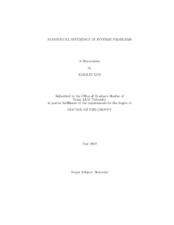| dc.description.abstract | Inverse problems have gained popularity in statistical research recently. This dissertation consists of two statistical inverse problems: a Bayesian approach to detection of small low emission sources on a large random background, and parameter estimation methods for partial differential equation (PDE) models.
Source detection problem arises, for instance, in some homeland security applications. We address the problem of detecting presence and location of a small low emission source inside an object, when the background noise dominates. The goal is to reach the signal-to-noise ratio levels on the order of 10^-3. We develop a Bayesian approach to this problem in two-dimension. The method allows inference not only about the existence of the source, but also about its location. We derive Bayes factors for model selection and estimation of location based on Markov chain Monte Carlo simulation. A simulation study shows that with sufficiently high total emission level, our method can effectively locate the source.
Differential equation (DE) models are widely used to model dynamic processes in many fields. The forward problem of solving equations for given parameters that define the DEs has been extensively studied in the past. However, the inverse problem of estimating parameters based on observed state variables is relatively sparse in the statistical literature, and this is especially the case for PDE models. We propose two joint modeling schemes to solve for constant parameters in PDEs: a parameter cascading method and a Bayesian treatment. In both methods, the unknown functions are expressed via basis function expansion. For the parameter cascading method, we develop the algorithm to estimate the parameters and derive a sandwich estimator of the covariance matrix. For the Bayesian method, we develop the joint model for data and the PDE, and describe how the Markov chain Monte Carlo technique is employed to make posterior inference. A straightforward two-stage method is to first fit the data and then to estimate parameters by the least square principle. The three approaches are illustrated using simulated examples and compared via simulation studies. Simulation results show that the proposed methods outperform the two-stage method. | en |


